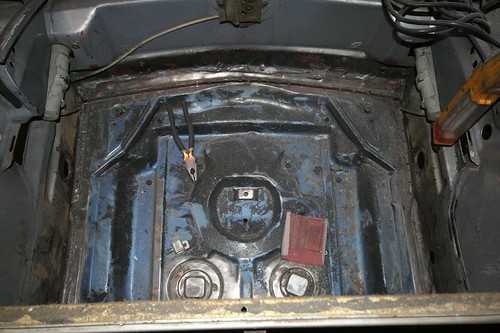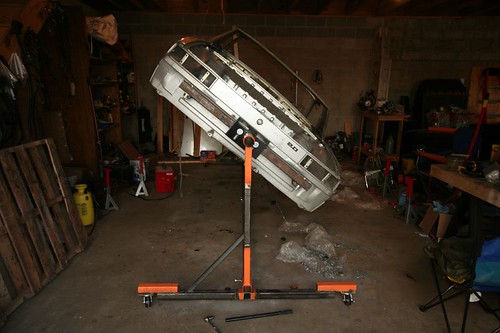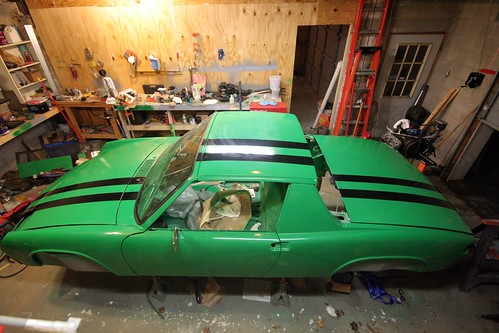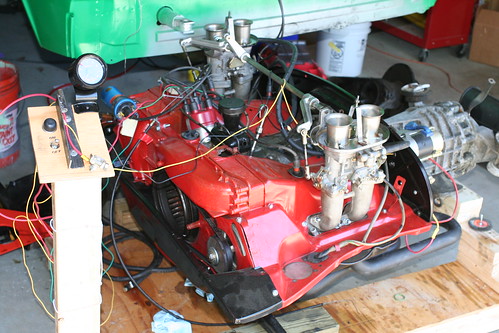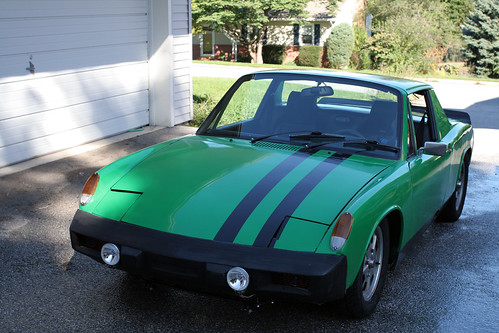
The completed unit
The ammo can that I decided to use was an East German, or possibly WWII Nazi issued 8mm box. I chose it as it was the same width as the standard NATO 30cal box, but just a little longer, which would give me room to mount everything in a narrower case then what I had seen pictured. Everything came in on time except for the 30 watt amplifier kit, which ended up being backordered for two weeks. All of the hardware not ordered from Parts Express came from the local True Value hardware store, except for a tube of electronic soldering flux which I picked up at Radio Shack.

The first thing that I did was sketch out what I wanted to make on graph paper. This let me determine before I started cutting where the best place to mount everything would be. Once I knew where I wanted it to go on the model, I marked off the center points on the ammo can, and cut them out with a 4 inch hole saw, a drill press, and lots of cutting oil. Holes cut; I dressed them with a pneumatic die grinder to remove and leftover flashing.
I thoroughly cleaned the face of the can from years grime and grease, and masked off the top and sides of the can, which I wanted to remain OD green, with 50 years of patina. I then primed the face, and then painted it John Deere yellow (which also happens to be a perfect match for all of the 1950 and 1960s era fallout and radiation bunker signs.) I let the paint dry for 24 hours before moving to the next step.


I covered the face with 2 inch blue painters tape, and drew on my stencil with a pencil and compass. The stencil was then cut out with a fresh razor, and the areas to be painted were peeled off, leaving a perfect mask. Two coats of satin black later, I was done painting. Once the paint had set, I pulled off the rest of the mask before the paint had time to completely dry and stick to the tape mask.

At this point I was ready to put in my insulation. I was using RaaMatt automotive deadener – and I will not be using it on future boxes I build. The black tar that sticks the stuff to anything made a mess once the speakers were mocked in for test fitting.
 To help solve the problem, I sprayed rubberized undercoating on all the insulated surfaces. This has helped, but not eliminated, the problem.
To help solve the problem, I sprayed rubberized undercoating on all the insulated surfaces. This has helped, but not eliminated, the problem.When the amp got in, I spent an evening soldering in the bits the needed soldering – which was not as much as I had expected. The amp, unlike many of the kit amps that I had found, came largely built. All I needed to solder on were the four speaker wires, aux power leads, and two output capacitors in line with the speaker wires. The amp was mounted onto the internal iPod pocket I had made out of some scrap sheet metal in my shop. It was attached with industrial strength mounting tape.

The final touch was to add rubber feet to the bottom and back face. This was to keep the metal can from rattling against whatever I had it set on when it was playing – or rattling against the wall if I had it hung up. The speakers can be used two ways. For outdoor usage, everything can be kept internally. The speakers will run off batteries, and the iPod has an internal pocket to keep it out of harm’s way. However, this makes it hard to change what you want to hear, and the batteries will eventually die. For regular usage, the iPod can attach to an input on the back of the speakers via a three foot cable. There is also a 12 volt AC adapter that plugs into the back of the set for constant use near a standard power outlet.
The set has surprisingly good bass given that it is only two 4 inch speakers. Sound quality is excellent, until the volume is turned up – at which point the amp picks up a interference and distortion. I have read that better output caps would help with that, as well as bridging the channels – which I did not do. That said it is considerably louder than the 3 watt per channel PC speakers that I had been using.
If I make more of these – either for sale or as gifts – the primary change I need to make is in insulation. I need to find something better then the automotive tar/asphalt based stuff that I used. A tall order, given the slender form factor I have to make use of In order to continue to use the 30cal ammo cans. Future units would also not use the internal iPod pocket, at least as I made mine. Fabric, instead of sheet steel, would be a simpler option.










